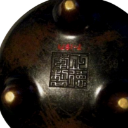The mark of Zhengde
Under the base of our incense burner is a mark of Ming Emperor Zhengde written in Chinese script, which reads zhengde nian zhi 正德年製, meaning ‘made in the Zhengde period’. The Zhengde Emperor, Zhu Houzhao 朱厚照 (1491-1521, reigned from 1506 to 1521), was the eleventh emperor of the Ming Dynasty. In the Ming period (1368-1644), ceramics based on Islamic metalwork appeared. During the reign of Zhengde, porcelain ware in Islamic forms, decorated with Arabic inscriptions, such as Qur’anic verses and Persian poems, were produced. The Zhengde Emperor himself was interested in Islam. It is said that he sometimes dressed in Arab costumes, and prohibited the consumption of pork.
It is also said that the high point of Islam in China was during the Ming era, because it was during this time that Muslims acquired unprecedented political influence.
Let’s now travel (further) back in time and across the seas!

](https://micrio.thingsthattalk.net/iPBgi/views/max/170x128.jpg)
](https://micrio.thingsthattalk.net/WsroN/views/max/128x128.s.jpg)